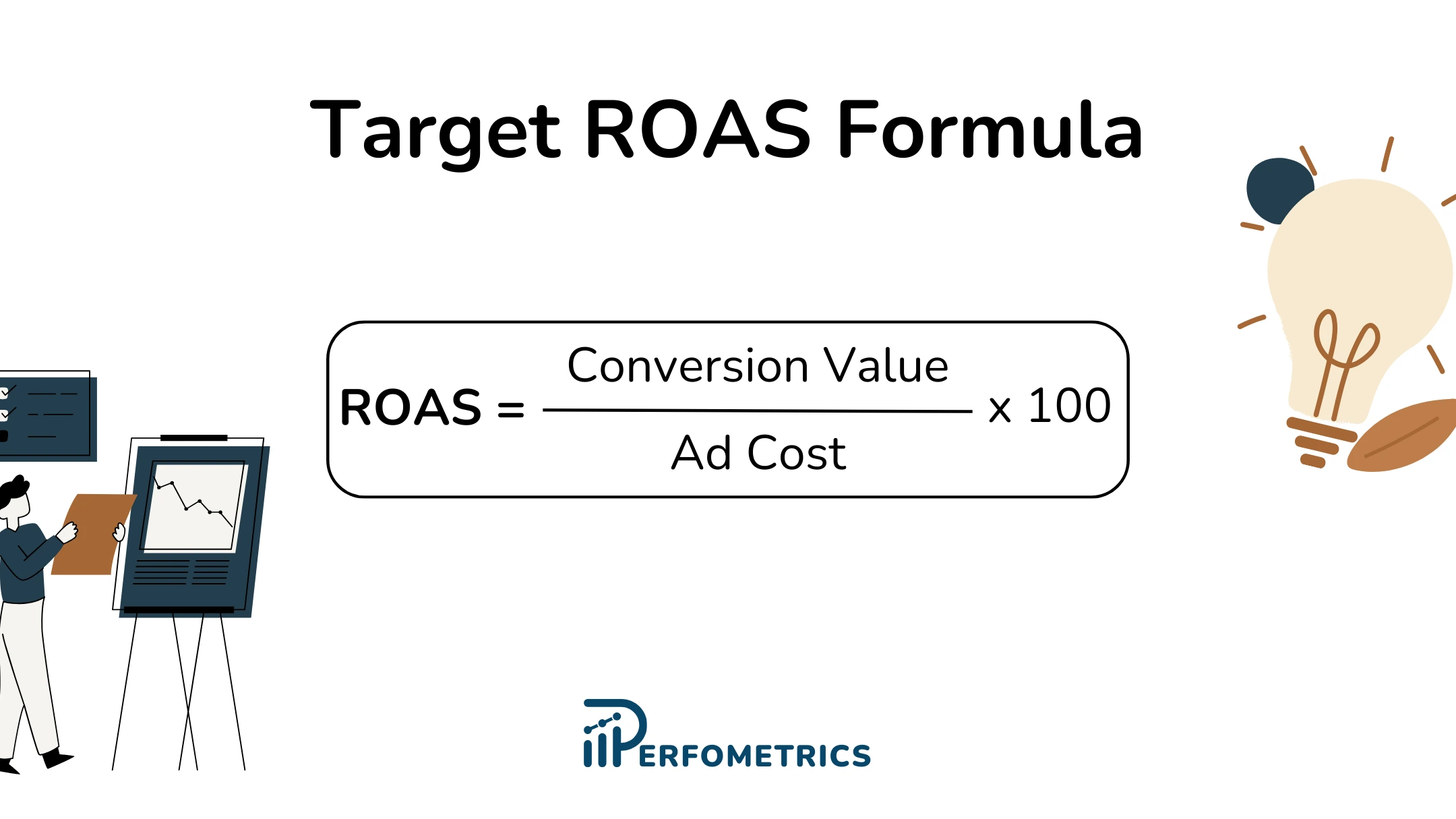Master the Target ROAS Bidding Strategy in Google Ads

In 2022, the digital ad spend market passed the $600 billion mark for the first time. This value it’s forecasted to continue growing in the years to come, which shows that businesses are investing heavily in digital advertising to stay competitive. In turn, this has led to a growing need for effective bidding strategies that can help advertisers achieve their desired ROAS and generate returns.
One such bidding strategy that has proven to be highly effective is the Target ROAS (tROAS) smart bidding strategy in Google Ads. With tROAS, advertisers can set a specific target ROAS value, and Google Ads will automatically adjust their bids to achieve that target. This strategy has the potential to save time and resources, while also improving campaign performance and generating higher revenue.
However, as with any Google Ads bid strategy, there are benefits and challenges to using tROAS, so let’s explore what tROAS is, when to use it, how to set it up, and what the ideal target ROAS looks like.
Note: Nowadays, target ROAS is not a separate strategy; you can find it within Maximize Conversion Value. This means you can set your desired tROAS under the Maximize Conversion Value strategy.
What is Target ROAS Bidding Strategy in Google Ads?
Return on ad spend is one of the most important metrics to track in digital advertising. In simple terms, target ROAS tells you how much revenue you’re generating for every dollar you spend on advertising. For example, if you set a target ROAS of 200%, Google Ads will adjust bids to generate $2 on average in revenue for every $1 spent on advertising. The higher your ROAS, the more profitable your advertising efforts are.
To help you optimize your ROAS, Google Ads offers a bidding strategy called Target ROAS (tROAS). This bidding strategy is part of the automated smart bidding group, which means that it uses machine learning algorithms to automatically set bids based on historical performance data. With tROAS, you set a target ROAS value, and Google Ads uses historical data to automatically adjust bids to achieve that target.
By setting a target ROAS and letting Google Ads do the heavy lifting, businesses can focus on other important aspects of their advertising campaigns. That being said, tROAS is not a set-it-and-forget-it solution. You still need to monitor your campaigns and know when to make adjustments.
There are 6 types of automated Google Ads bidding strategies – Target ROAS being one of them. As an overview, the table summarizes the different types of automated smart bidding strategies and their goals.
| AUTOMATED BID STRATEGY | MARKETING OBJECTIVE |
| Maximize Clicks: Aims to get you as many clicks within the budget | Increase website visits |
| Target Impression Share: Shows your ad on top of the page anywhere and on search results | Increase visibility |
| Maximize Conversions: Optimize for more conversions | Increase the number of conversions |
| Maximize Conversion Value: Optimizes for more conversion value | Increase conversion value |
| Target CPA: Get as many conversions as the target cost-per-action you set | Get more conversions at your target CTA |
| Target ROAS: Get as much conversion value at the target return on ad spend you set | Get more conversion value at your target ROAS |
What Is The Ideal Target ROAS?
When using the Target ROAS (tROAS) bidding strategy in Google Ads, one of the most important decisions that you need to make is what your target ROAS value should be.
Truth is, there is no golden number. The ideal tROAS will vary from business to business and even from campaign to campaign, depending on a number of factors such as the industry, competition, and profit margins.

A good place to start is the historical conversion value per cost data. Look at this figure for the ad group or campaign you’re interested in. Note that the tROAS you set can influence other aspects of your campaign performance, such as the amount of traffic your ad may get.
Note: Look at the conversion value/cost column in Google Ads to find this metric.
If you are just starting out and do not have historical data to look at, look at your business numbers. “How much do you need to generate in ROAS to be profitable or to break even?” You can that information and then apply it to your Google Ads campaigns.
In general, the ideal tROAS will be the one that maximizes revenue while keeping ad spend within the advertising budget. Arriving at your ideal ROAS will require careful monitoring and adjustment of tROAS targets over time, as campaign performance and market conditions change.
How to Set Up Target ROAS Bidding
Let’s move on to how you can start using this bidding strategy. Here is the step-by-step guide to setting up tROAS bidding.
Step 1: Set Up Conversion Tracking
Before you can use tROAS, you need to set up conversion tracking in your Google Ads account. This allows Google Ads to track the performance of your campaigns and adjust bids based on the target ROAS you set. You can read Google’s documentation on how to set up conversion tracking for your website.
Step 2: Choose Your Campaign Type
Not all campaign types are eligible for tROAS bidding. Currently, this strategy can be used for Search, Display, Shopping, App, Discovery, and Video campaigns. Choose the campaign type that best aligns with your advertising goals. For a more in-depth look at this topic, check our guide on Google Ads campaign types and how to choose the right one.
Step 3: Add tROAS Bidding Strategy
Once you’ve created or chosen your campaign:
- In Campaigns, select the campaign you want to edit
- Navigate to the Settings tab
- Scroll down to Bidding
- Select Maximize Conversion Value
- Input the desired target ROAS
- Save
Step 4: Set Your Target ROAS
We covered how to find your ideal tROAS in the above sections. Next, you have to choose a target ROAS that aligns with your specific campaign goals and budget. Now it’s time to add that value to your campaign.
Step 5: Monitor & Adjust Performance
As we said, tROAS is not a set-it-and-forget-it strategy. None of the automated bidding strategies are.
After setting up tROAS, it’s important to monitor your campaign performance regularly. Review your conversion data and adjust your target ROAS and bid strategy as needed to achieve the desired return on ad spend.
When to Use the Target ROAS Smart Bidding Strategy?
So, when should you choose this bidding strategy over all the others? Finding the right bidding strategy is a challenge on its own. Alas, a very important decision that greatly influences your campaign’s performance.
To make the right choice, it’s important to understand when it’s best to use this strategy and what the potential benefits and challenges are.
The target ROAS bidding strategy applies to all businesses as long as the ROAS is defined and the value is tracked with each conversion. This strategy is widely recommended for e-commerce businesses but it’s also applicable for lead generation and service businesses. The key is feeding back to Google Ads the right value of your conversions; as long as tracking is correct you can use it and optimize for it. Also, it’s crucial to understand what is the break-even point for your business, this is the ground zero point from where you start.
The table below summarizes the above points and can help you choose the right bidding strategy for your campaign.
Benefits of Target ROAS
One of the primary benefits of tROAS is that it allows you to focus on achieving a specific target return on investment (ROI). This can be especially useful for businesses that have specific revenue targets or profit margins that they need to meet. By using tROAS, advertisers can adjust their bids in real-time to ensure that they’re generating the highest possible ROI for their advertising spend.
Another benefit of tROAS is that it can be more efficient than manual bidding strategies. This is because the tROAS bidding algorithm uses historical performance data to make bid adjustments automatically, rather than requiring manual input and adjustment. This can save you time and resources, allowing them to focus on other aspects of their advertising campaigns.
Challenges of Target ROAS
However, there are also some potential challenges associated with tROAS. For example, if you set the target ROAS too high, it can limit the reach and performance of their campaigns. This is because the bidding algorithm may not be able to generate enough conversions at the target ROAS level to justify the ad spend.
Another challenge is that tROAS bidding requires a significant amount of historical performance data in order to be effective. Specifically, most campaign types need a minimum of 15 conversions in the past 30 days. If you are running a new campaign or one with limited historical data, it may not be possible to use tROAS effectively.
That’s to say, If you have a specific ROI target that you need to meet, and you have sufficient historical performance data, then tROAS can be a powerful tool for optimizing return on ad spend. However, it’s important to be aware of the potential challenges and limitations of this bidding strategy and to be prepared to adjust strategies and targets as needed.
Final Thoughts
Target ROAS smart bidding strategy is a powerful tool for optimizing return on ad spend in Google Ads campaigns.
By setting a target return on ad spend, Google Ads uses machine learning algorithms to automatically adjust bids and maximize ROAS. With careful setup and ongoing adjustments, it can effectively increase revenue and enhance campaign performance.
- Target ROAS (tROAS) is an automated smart bidding strategy in Google Ads, setting a specific return on ad spend.
- Common challenges of using Target ROAS include a lack of conversion data, difficulty finding the ideal tROAS, and balancing ROAS and volume.
- Ideal tROAS varies by business, influenced by industry, competition, and margins.
- Setup involves conversion tracking, selecting the right campaign type, and inputting the desired tROAS.
- Regular monitoring and adjustments are necessary for optimal performance.
- Best suited for businesses with clear ROI goals and sufficient conversion data.



